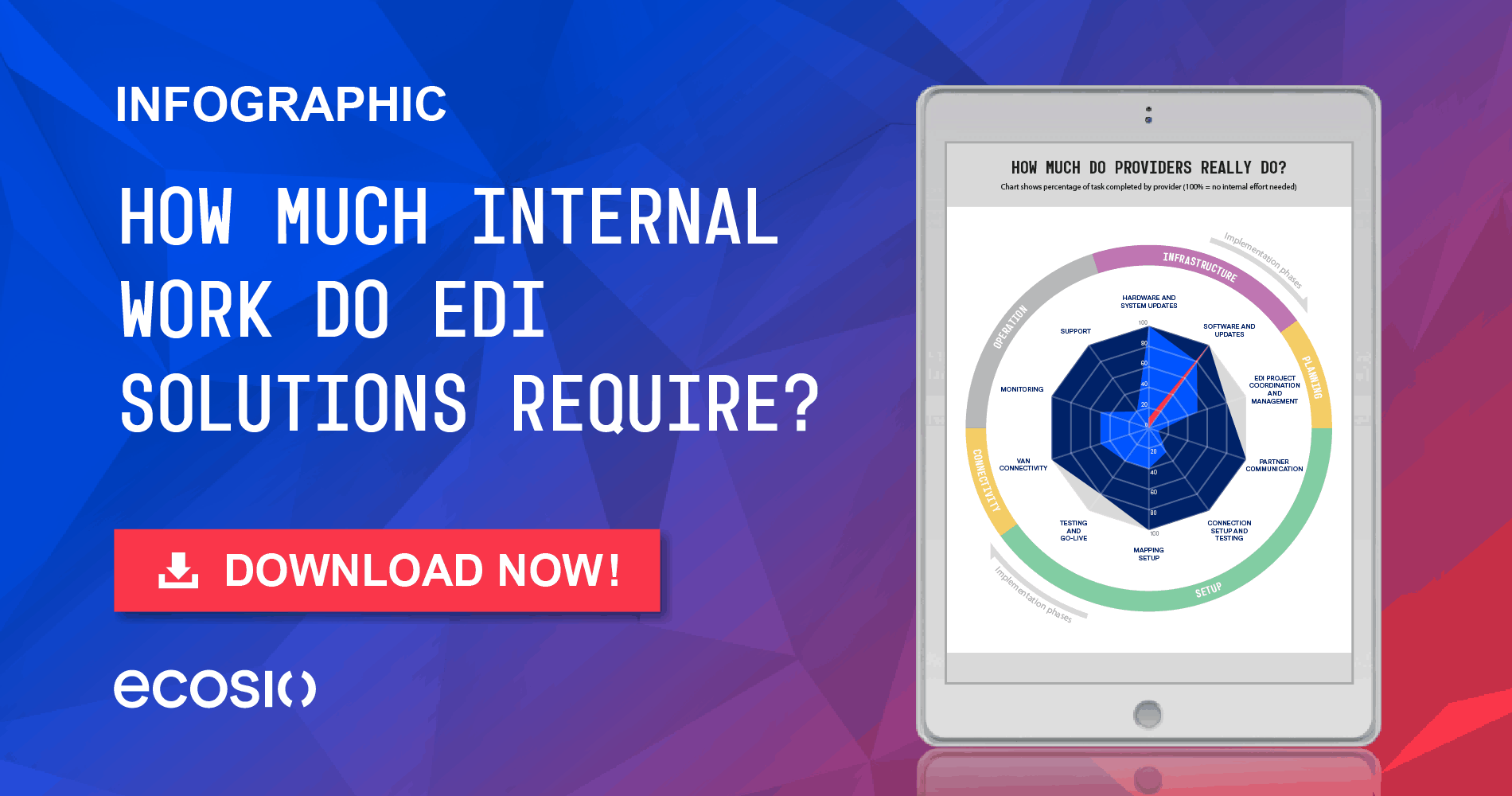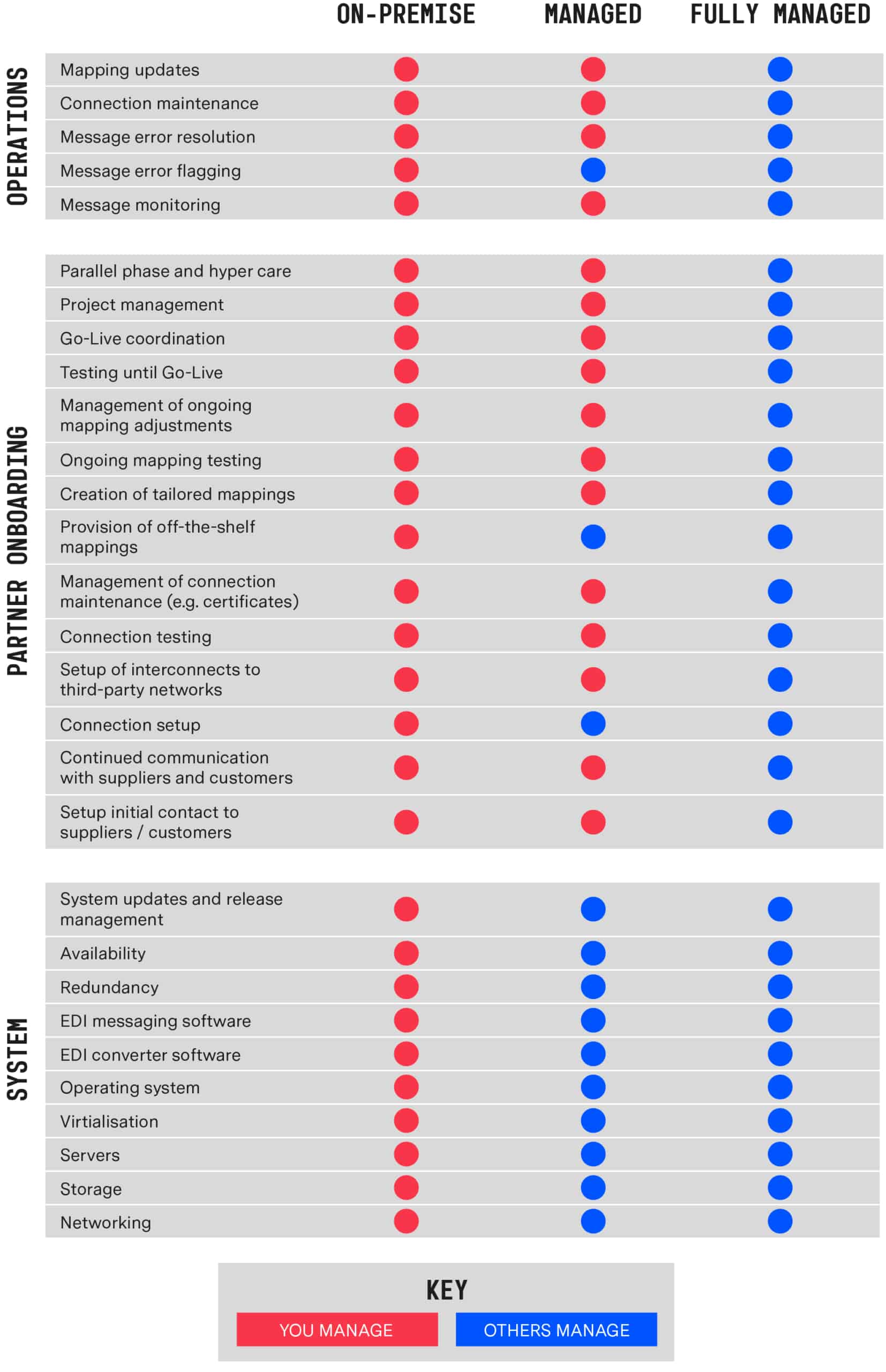With such a large number of EDI solution providers out there, all of whom offer slightly different products and services, assessing the value of different packages can be a long and complex process. From where the solution will be hosted, to what functionality is included in your package, there are a multitude of factors to consider when selecting the best EDI solution for your business.
One of the most important decisions that businesses must make at this crucial point is the extent to which they want their provider to manage their EDI solution (from set-up and operation to monitoring and error resolution). Unfortunately, however, the term ‘managed EDI’ is used to mean different things by different providers and is therefore frequently misunderstood by those selecting a solution. In turn, this can lead to huge expense further down the line as in-house teams struggle to run their new system efficiently in conjunction with the unexpectedly minimal support offered by their provider.
In order to help you to avoid experiencing such a situation, in this article we’ll examine the full breadth of what providers mean when they talk about ‘managed EDI’, looking in detail at the areas where some providers’ supposed management is often lacking.
First, though, let’s briefly recap the basics of electronic data interchange…
The basics of EDI
Electronic data interchange offers businesses a means of exchanging key business documents with partners automatically – i.e. with minimal human intervention. The data from commonly exchanged documents such as invoices, order confirmations and delivery notes are translated into computer-readable formats and sent to business partners via standardised EDI protocols.
This method of exchanging data removes the need for manual data input/extraction, thereby minimising errors and improving the speed, cost and efficiency of B2B document exchange. A good EDI system also offers businesses flexibility and scalability, as automated processes require less internal work than manual ones.
In short, EDI allows your business to operate more smoothly as connections with partners are streamlined and reliable.
Common issues with existing EDI solutions
Despite the compelling benefits of EDI, many EDI systems sadly fall short of offering users the full potential of the technology. This is due to a number of issues with commonly implemented solutions…
1) They require too much in-house effort/expertise
This is undoubtedly the most common issue encountered by EDI users. In addition to expertise being necessary to set up an EDI solution, ongoing operation also requires effort (e.g. monitoring message exchange and resolving errors). Unfortunately, such tasks are often not considered when selecting a solution, however. As a result, many businesses end up with a solution that requires substantial in-house expertise/resources.
While this may be fine for those businesses who have extensive in-house EDI expertise, for those that don’t it stops employees from focussing on more value-adding tasks. Similarly, even if your team is able to cope with current requirements, handling EDI in-house limits scalability. Further, handling EDI in-house can also lead to an reliance on individual employees, which can lead to issues come illness or departure.
2) They offer poor support
Another key frustration for those with substandard EDI solutions is the difficulty of getting hold of someone to help you when issues arise (e.g. if a message is stuck somewhere and has not reached your partner for some reason). Given the significance of the documents being exchanged via EDI and the pace of modern supply chains, this can have a significant knock-on effect on revenue and business relationships.
3) They may inhibit your business’s flexibility through “price cliffs” or limited technical scope
While all EDI solutions should enable you to exchange automated messages with your partners, different providers offer very different packages. In particular, some solutions may be extremely rigid in terms of the technical capabilities offered, meaning you may not be able to adapt your solution as needs change (e.g. should you want to send messages via a new protocol or introduce a Web EDI platform for smaller partners). Likewise, the flexibility of your system may be limited thanks to a solution’s pricing structure, with some providers charging extortionate amounts for even minor changes to solution functionality.
The three main cloud-based solution types
Cloud-based solutions generally fall into one of the following three categories: Infrastructure as a Service (IaaS), Platform as a Service (PaaS), or Software as a Service (SaaS).
1) IaaS
IaaS relieves users of the need to purchase the physical equipment (e.g. servers). IaaS solutions may also provide operating system, disk storage and messaging resources. By opting for an IaaS system rather than an in-house solution, businesses avoid the considerable upfront costs associated with on-premise setup and remove the dangers associated with a single point of failure system.
Although an IaaS model offers customers substantial control, users are also responsible for installing and running their own software systems and must conduct all necessary maintenance/upgrades themselves.
2) PaaS
PaaS models provide a framework for in-house developers, on which they can build custom applications as required. PaaS systems do not allow for the direct use of software via the internet, but instead provide access to a platform where the necessary software applications can be created.
3) SaaS
SaaS offers access to cloud-based software. This removes the need for applications to be built or for software to be downloaded and installed on every machine. This solution model is highly scalable and is much faster to set up than IaaS and PaaS, which both require substantial internal effort.
Managed platform or a managed EDI service?
Of these three cloud-based models, SaaS is the only one which does not require considerable internal work, with the EDI partner instead providing all the necessary IT elements for a successful EDI solution. As a result, IaaS and PaaS are referred to as managed platforms, while an SaaS solution is generally referred to as a managed service model.
However, as we shall explore, not all SaaS EDI solutions are born equal. As anyone familiar with EDI will know, there is much more to successful EDI than simply setting up the basic functionality. While many SaaS EDI solutions are described as ‘managed’, this often refers purely to the fact that they provide the elements necessary for EDI to be conducted via the cloud; significantly it does not necessarily mean that they offer any help when it comes to the key EDI areas where businesses experience the most issues, such as partner onboarding or message monitoring. Those solutions that offer valuable assistance regarding the setup, operation and maintenance of EDI systems in order to lighten the load on internal teams are more accurately referred to as fully managed EDI solutions.
While they may sound similar (and both differ from on-premise solutions), managed and fully managed EDI solutions are very different and should not be confused.
What is fully managed EDI?
A fully managed / full service EDI solution, such as that offered by ecosio, is one in which the EDI provider handles all EDI tasks, from technical setup and message testing etc. right through to ongoing operational tasks such as message monitoring and error handling. It is for this reason that full service EDI providers are known as fully managed EDI providers – they manage everything for you! Just how much of the work required to set up and run a successful EDI solution is handled by a fully managed EDI provider compared to other providers can be seen in our helpful infographic on this subject here.
Fully managed EDI solutions also typically offer much better support and more flexibility than other EDI solutions, and may even be able to offer better data transparency too. Crucially these qualities allow businesses to avoid the common issues listed above.
The table below illustrates the considerable differences between the three types of solution over the life cycle of an EDI project:
The three key areas where managed EDI differs from fully managed EDI
While, as the table above clearly illustrates, there are many ways in which managed and fully managed EDI solutions differ in terms of what the provider is able to do, there are three main differences that it is worth exploring in more detail…
1) Partner onboarding
Partner onboarding is arguably the area where there is the biggest disparity between fully managed EDI solutions and those that claim to offer managed EDI. As those who have onboarded EDI partners before will know, the process can take a frustratingly long time if a proactive approach is not taken.
…with ‘managed EDI’ solutions
Unfortunately, it is common for ‘managed’ solution providers to complete only the basic initial mapping and pass the responsibility for testing the connection to their customer. In this scenario, the purchaser of the EDI solution has to chase their partners for whatever data or documents are required. As well as being a time-consuming exercise, when issues are discovered that require mapping to be adjusted, the solution purchaser then has to act as a middleman between their partner and their EDI solution provider. In turn, this further increases the time of the project and the likelihood of errors and oversights occurring.
It is important during this phase to test all possible message exchanges, including all variations of a document (e.g. invoices with and without VAT). However, as many supply chain organisations are unaware of what thorough testing involves, their testing is often far from comprehensive. Having received no help during the testing phase from their ‘managed’ solution provider, businesses in this situation are then likely to experience many errors following go-live. Depending on the number of partners and exchanges involved, this can be extremely expensive to fix!
…with fully managed EDI solutions
With a fully managed EDI solution such as ecosio’s, virtually all of the internal effort is removed. These solutions will provide businesses with a dedicated integration engineer whose job it is to chase down information from partners and ensure that testing is conducted as thoroughly as possible, preventing issues further down the line. Not only does this have a dramatic impact on the time in which partner onboardings can be completed, as EDI integration engineers have a wealth of testing experience, clients can be sure that their connections will be extremely reliable before going live.
For a comprehensive rundown of the steps involved in supplier EDI onboarding, read our article “Supplier EDI Onboarding – The Seven Key Steps” on this.
2) Message monitoring
While establishing connections may be the most technical aspect of implementing an EDI solution, effort is also required to ensure the solution is operating correctly from day to day.
…with ‘managed EDI’ solutions
With the average ‘managed’ EDI solution day-to-day message monitoring is handled exclusively by the client. This involves regular checking to ensure no messages are stuck and that there are no errors with incoming or outgoing documents.
…with fully managed EDI solutions
With a fully managed EDI solution the pressure of checking message statuses and delivery / error notifications is removed. Instead, your provider will oversee the smooth running of the system, which should include setting up automated alerts and flags for different occurrences.
Further, providers offering a comprehensive service may also be able to offer clients a depth of data visibility simply not possible in less complete solutions. For example, as it is directly integrated into clients’ systems via API, ecosio’s Integration Hub provides users with unparallelled data visibility, allowing users to see information on every stage of message exchange. What’s more, this information is all visible within their existing ERP user interface!
3) Support + error handling
No matter how much care is taken during system setup to avoid errors, the nebulous nature of EDI standards, formats and protocols is such that they are inevitable from time to time. With this in mind, and given the hugely detrimental impact errors can have on profits and partner relationships, it is important to have reliable processes in place to deal with errors when they occur. This includes not only error identification, but also resolution.
…with ‘managed EDI’ solutions
With most ‘managed’ EDI services, the provider’s error handling is reactive at best. Generally the responsibility for identifying errors lies solely with the solution purchaser. It is then the purchaser’s responsibility to notify their provider of the issue and chase until it has been resolved.
As the level of support offered by ‘managed’ solution providers varies, however, this can be a frustrating process. Despite the business critical nature of EDI, customers often find it difficult to get through to someone with sufficient knowledge of the situation to help them resolve the issue. In some cases the ‘support’ offered by providers is simply a generic support email address, with customers left in the dark as to when they can expect to hear back.
…with fully managed EDI solutions
With fully managed solutions error handling and support is proactive, not reactive. A good solution should be able to spot errors quickly and instantly start the process of resolving them. Ideally this process should be so smooth that errors can be resolved before they are even noticed by anyone else.
For example, if an incoming order fails, there is no need for the client to spot this and notify their provider. Instead, as they are responsible for monitoring message flow, the provider should spot this and contact the sender directly to ensure the necessary amendments are made to enable the message to be sent successfully. Nothing is required from the client!
When it comes to support, fully managed solutions also offer far higher quality. Clients should have a dedicated integration engineer who they can contact who understands their business and knows their partners, and is therefore well positioned to resolve any issues quickly.
The benefits of fully managed EDI
From a business perspective, the most compelling benefits of fully managed EDI can be usefully condensed into four categories…
1) Fully managed EDI saves you time
While all EDI is capable of saving users time through minimising manual processes and increasing data accuracy, fully managed EDI enables businesses to multiply these savings further by…
- Allowing internal teams to focus on core competencies, as all EDI tasks are handled by your solution provider
- Reducing time required for partner onboardings through external project management and use of intelligent tooling such as automated testing
- Shortening error resolution time through deep ERP integration and full-text search across all EDI messages, which enables delivery errors to be spotted quickly
- Freeing up internal teams from EDI onboarding and support tasks, allowing them to concentrate on more value-adding activities
2) Fully managed EDI saves you money
Arguably the clearest and most convincing benefit of fully managed EDI is its capacity to save businesses money. Fully managed / full service EDI enables users to…
- Reduce the total cost of ownership (TCO) of B2B processing, as EDI is offered as a scalable service on a pay-per-use-basis
- Experience flexible, cost-efficient growth, as new features and connection types can be added in modular fashion without prohibitive “price cliffs”
- Minimise cost-intensive manual tasks by getting EDI connections to a working state faster, since onboarding tasks are handled by specialised external teams
Note: While on-premise and partially managed EDI solutions may initially appear cheaper, when CAPEX, OPEX and other indirect costs are all taken into account, fully managed / full service EDI almost always offers superior value.
3) Fully managed EDI reduces your operational risk
In addition to helping businesses save money, fully managed / full service EDI providers such as ecosio also serve to reduce risk by…
- Ensuring the highest possible level of availability through the operation of multiple redundant servers
- Ensuring your solution is always cutting-edge through regular, automatic installation of software/security updates
- Making sure your solution’s success isn’t dependent on individuals, as message exchange is overseen by dedicated experts
- Detecting potential message delivery errors and resolving them as quickly as possible thanks to continuous monitoring
As a result, businesses that opt for a fully managed EDI solution need not worry about issues such as damaged partner relationships, fines, deterioration of solution efficiency or catastrophic data loss. Fully managed EDI ensures that no matter what, your electronic processes stay up and running.
4) Fully managed EDI increases your competitive advantage
As well as making life easier for internal teams, fully managed / full service EDI also places businesses using such solutions at a distinct advantage compared to their partners. This is due to the fact that fully managed EDI helps you…
- Focus on your core business while supporting EDI tasks are taken care of by a specialised service provider
- Stay competitive in the long-run, as fully managed solutions can easily be adapted to suit changing requirements (e.g. introducing a Web EDI platform or fulfilling country-specific e-invoice requirements)
- Boost business relationships, as partners’ EDI requirements can be met faster and more accurately
What’s more, fully managed EDI also boosts the attractiveness of the business in question to prospective partners, with benefits such as fast onboarding and round-the-clock message monitoring/error resolution, likely to be particularly appealing.
Why fully managed EDI is the future of B2B integration
Given the benefits of fully managed EDI it’s no wonder that more and more businesses are adopting this approach. In fact, fully managed EDI is set to become the new norm in the coming years.
Far from being replaced by new technologies such as API (as has been wrongly predicted by many over the years), EDI is now more crucial than ever to business processes. While large industry players demand ever more detailed data from suppliers, many businesses are also looking to extend B2B message exchange automation across as much of their supply chain as possible, with Web EDI platforms now allowing even the smallest suppliers to send documents via EDI. In many countries, too, the use of EDI – particularly e-invoicing – is now being actively encouraged and even mandated by governments. Meanwhile the Covid-19 crisis prompted many businesses to step up B2B integration efforts in order to improve supply chain sustainability.
As the scope and popularity of EDI has grown, however, so has the effort and expertise required to set up and operate a successful EDI solution. As a result, while handling EDI in-house may still be possible for those businesses with a wealth of internal EDI expertise, for most organisations a full service approach via the cloud offers a more logical and futureproof solution.
Just as we no longer have to think about how our phone calls are connected to the person on the other end (thanks to our network providers sorting this for us), so modern businesses are recognising that they no longer have to concern themselves with the technical intricacies of EDI document formats and protocols. By offering businesses security, flexibility and (perhaps most notably) the freedom to focus on what they do best, full service EDI is undoubtedly the future of B2B integration.
For more info on what the future of EDI might hold, see our article on the five top trends in EDI here. Alternatively, a more detailed exploration of how EDI is likely to evolve in the coming years can be found here.
Conclusion
As you should now recognise, managed and fully managed EDI are by no means the same. Whilst not all managed solutions offer the same exact services and some offer more than others, none can compete with fully managed solutions in terms of the extent to which they relieve pressure on internal teams.
Unfortunately, as providers often veil the limited nature of the service they provide, many businesses find themselves stuck in contracts they can’t get out of with solutions that require more resources and expertise to maintain than are available. Given that EDI contracts are usually fairly long, this commonly results in either the business in question having to pay over the odds for additional support from their provider or external consultants, or struggling to handle complicated processes in-house.
To avoid these situations it is extremely important to select a provider whose services fit your requirements. With a better understanding of the differences between managed and fully managed EDI, hopefully you are now more aware of what questions to ask prospective providers to establish the extent of their offering and make the right choice.
Looking to experience the benefits of EDI with minimal internal effort?
Efficient EDI is essential for ambitious supply chain organisations. However, integrating, running and maintaining a successful solution takes time and expertise. As these are commodities that few supply chain organisations have at their disposal, at ecosio we offer a fully managed service.
Over the years we’ve connected thousands of companies and understand exactly what effective EDI involves. With a single connection to our powerful Integration Hub, our partners benefit from unparallelled end-to-end data visibility. Meanwhile, our experienced integration engineers and EDI experts oversee every connection so you don’t have to.
In short, we take care of all your EDI needs, from mapping and testing to message monitoring and error resolution… and everything in between, leaving you to concentrate on whatever it is your business does best.
For more information, contact us today!




